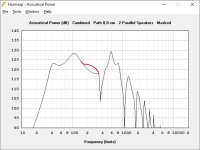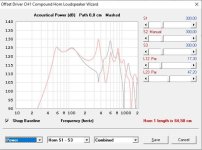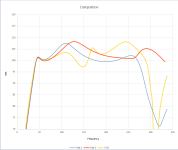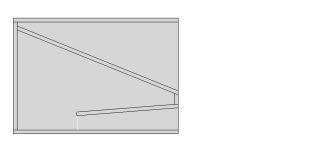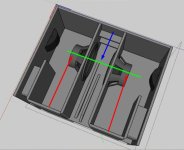So the name of this thread is "Would a Single driver Manifold/MTB be better than Tapped Horn?"
The mayor advantage I see with the Manifold design over TH, is the ability to easily change port tunings, by replacing ports or just blocking them. Changing tuning is not possible with a TH, unless it has a large enough throat chamber, that the driver can be flipped around. Flipping a driver around is however not as easy as shoving a sock in a port.
Also I have found that by making the horn section streight, I can achive better results and be able to install drivers, without the need for a access door.
Having a streight horn also makes construction super simple.
By making dual bins, it is possible to make a very small horn, but still be able to install drivers from the front.
Here is a version 3.0 of my 212 bass bin:
Drivers are 2x B&C 12NDL76
High tune: All 8 ports open
Low tune: 4 ports open, this gets you bass heads down to 40hz, but with significantly lower SPL.
A medium tune and a super low tune is also possible, but not included in the images.
The mayor advantage I see with the Manifold design over TH, is the ability to easily change port tunings, by replacing ports or just blocking them. Changing tuning is not possible with a TH, unless it has a large enough throat chamber, that the driver can be flipped around. Flipping a driver around is however not as easy as shoving a sock in a port.
Also I have found that by making the horn section streight, I can achive better results and be able to install drivers, without the need for a access door.
Having a streight horn also makes construction super simple.
By making dual bins, it is possible to make a very small horn, but still be able to install drivers from the front.
Here is a version 3.0 of my 212 bass bin:
Drivers are 2x B&C 12NDL76
High tune: All 8 ports open
Low tune: 4 ports open, this gets you bass heads down to 40hz, but with significantly lower SPL.
A medium tune and a super low tune is also possible, but not included in the images.
Attachments
-
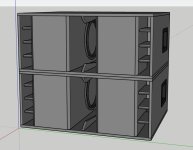 2x Manifold 212 v3.JPG43.2 KB · Views: 16
2x Manifold 212 v3.JPG43.2 KB · Views: 16 -
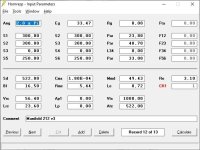 hornresp 540watts.JPG52.1 KB · Views: 16
hornresp 540watts.JPG52.1 KB · Views: 16 -
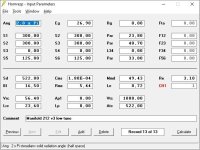 hornresp low tune 360watts.JPG53.6 KB · Views: 16
hornresp low tune 360watts.JPG53.6 KB · Views: 16 -
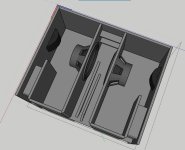 Manifold 212 v3 inside.JPG97.3 KB · Views: 16
Manifold 212 v3 inside.JPG97.3 KB · Views: 16 -
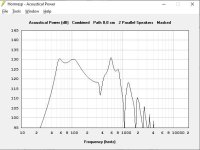 max SPL 540watts.JPG41.7 KB · Views: 15
max SPL 540watts.JPG41.7 KB · Views: 15 -
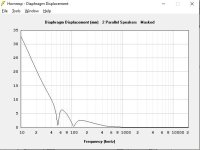 max SPL displacement 540watts.JPG33.7 KB · Views: 16
max SPL displacement 540watts.JPG33.7 KB · Views: 16 -
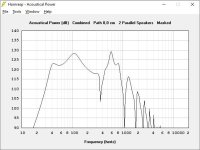 max SPL low tune 360watts.JPG42.9 KB · Views: 17
max SPL low tune 360watts.JPG42.9 KB · Views: 17 -
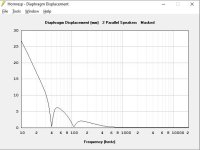 max SPL displacement low tune 360watts.JPG33.8 KB · Views: 16
max SPL displacement low tune 360watts.JPG33.8 KB · Views: 16
Also I have found that by making the horn section streight, I can achive better results and be able to install drivers, without the need for a access door.
Looks like you are loosing some SPL close to 200Hz, try to change drive offset position close to S1, the total front horn length is the same but the driver place closer to dead end.
In addition to that, you can keep the vent straight, but probably you flare the front horn you can improve upper frequency range as well. Try to reduce S2 and increase S3 as much as possible and compare the SPL behavior.
I moved them forward, because is removes the crazy third spike and deep valley, also seen in @Booger weldz post #244visually speaking, you can improve SPL in the area indicated by red line.
Also it very slightly increases SPL at around 100hz, which I care more about.
The final reason is simply that it makes driver installation easier.
Red is driver right at the back.
Thoughts?
Attachments
I moved them forward, because is removes the crazy third spike and deep valley, also seen in @Booger weldz post #244
Also it very slightly increases SPL at around 100hz, which I care more about.
The final reason is simply that it makes driver installation easier.
Sure, also try to evaluate S2 size, reducing S2 will provide additional improvement combined with increased S3.
So understand the effect of each variable over SPL you can better define your trade off case. Maybe the best results might be in the middle.
It worth to mention also that the lower frequency is defined by the rear chamber and vent, but the front chamber has a big impact in the upper range.
The option 1 and Option 2 in the image has exactly the same box volume but the ratio for the box are different:
Opt1 = depper lenght smaller horn mouth and bigger S1
Opt2 = taller box, bigger mouth and smaller S1
There are many variable you can play with to slowly optimizing the result in the direction you want.
With automation tool for freecad you can reduce a lot of time in this optimization routine.
The option 1 and Option 2 in the image has exactly the same box volume but the ratio for the box are different:
Opt1 = depper lenght smaller horn mouth and bigger S1
Opt2 = taller box, bigger mouth and smaller S1
There are many variable you can play with to slowly optimizing the result in the direction you want.
With automation tool for freecad you can reduce a lot of time in this optimization routine.
Attachments
I moved them forward, because is removes the crazy third spike and deep valley, also seen in @Booger weldz post #244
Thoughts?
That sucker rings like crazy in my junk, good thinking if you find some affective acoustical shape/offset to avoid it
I wonder how much more affective you can manipulate this reflection (red) to work in your favor ?
I think the only one you’re describing to horn response is the one in the center section(blue)
I think the only one you’re describing to horn response is the one in the center section(blue)
Attachments
Last edited:
Reducing S2 and increasing S3 tunes the high frequency resonator and the kick bass 2nd spike up. Sure it ups the efficiency of that spike, but at the cost of efficiency at around 80hz, which is way more important in my opinion.Sure, also try to evaluate S2 size, reducing S2 will provide additional improvement combined with increased S3.
So understand the effect of each variable over SPL you can better define your trade off case. Maybe the best results might be in the middle.
- Home
- Loudspeakers
- Subwoofers
- Case for Discussion - Would a Single driver Manifold/MTB be better than Tapped Horn?
